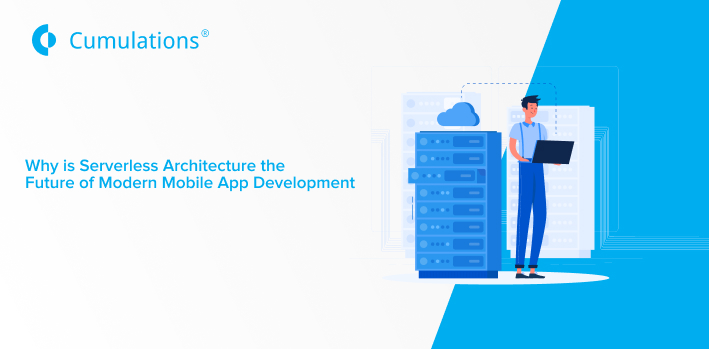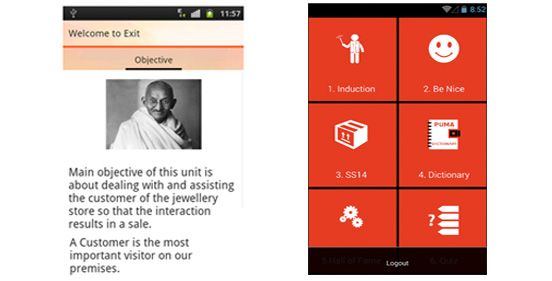
Serverless Architecture is slowly becoming the face of App Development’s backend. Serverless Architecture is actually a misnomer. The code from the developer’s keyboard eventually has to run through a server. It’s just that the job of deployment and maintenance won’t be on your shoulders. You outsource those processes to third party vendors often known as cloud companies. Amazon Web Services, Microsoft Azure, and Google Cloud are some of the top dogs in the game. Let’s dive in further and find out why a serverless architecture is considered the future of the backend component in Mobile app development.
What is Serverless Architecture?
A software design pattern wherein the infrastructure is provided by a third-party vendor is known as a serverless architecture. This implies that you outsource deployment, resource allocation, provisioning, scaling, OS maintenance, and process monitoring. Once the company shakes hands with these service providers, they have to install an API at their end to access the services provided by the vendor.
The vendor then provides the necessary tools for processes like testing, debugging, maintenance, monitoring, security, etc. Owing to the event-driven nature of the serverless architecture, the app owner simply needs to decide which tools to use.
Since the usage is event-driven, so is the payment. Although the payment sits upon the number of resources used, it works on the Pay-as-you-go model when the service paradigm is FaaS, which proves to be convenient for a company of all sizes.
The serverless architecture lets the app owner focus solely on development and business objectives and increasing value without worrying about the server-side logic or state i.e. infrastructure maintenance, scalability, or fault tolerance.
Serverless architecture can run on two different paradigms:
Backend as a Service (BaaS)
In a BaaS paradigm serverless architecture, the developer can just focus on writing application code or business objectives and doesn’t have to worry about maintaining servers for running and deployment of the code. In this concept, the infrastructure on which the code runs is owned by third-party vendors. Backend as a Service provides generic elements used in applications clubbed with a custom front-end component. In BaaS, the in-house developers are not even responsible for the backend logic.
It is generally seen that BaaS services run continuously once it is started. Hence the enterprises have to pay for these services in idle time too. Different server-side capabilities offered by BaaS are Database Management, Cloud Storage, User Authentication, Remote Updating, etc.
Function as a Service (FaaS)
Function as a Service (FaaS) is slowly taking over Backend as a Service when it comes to the paradigm of serverless architecture. In FaaS, the in-house application developers have the flexibility of creating the backend logic but are not responsible for its implementation.
The programmers assemble the backend logic code into building blocks called functions. FaaS has methods identical to microservices, where a monolithic application is split into small and manageable microservices that can be scaled individually and parallelly. In FaaS, even the microservices are broken further into different functions.
In FaaS, whenever any request comes to function, the service provider creates the instance for the developer’s end to run the code. The vendor also scales the function when multiple requests come to function. Similarly, the flexibility of scaling down the function, when they are not needed or their session time is over, is also there.
A great edge that FaaS provides over BaaS is that the services don’t need to run continuously and hence the cost incurred is just that of running the functions. This reduces the cost for organizations considerably.
Let’s take a look at some of the advantages that play an important role in the popularity of serverless development that is computing among developers and app owners.
Advantages of a Serverless Architecture:
Effortless Operational Management
When the objective is to develop a solution, the condition of the infrastructure is always a bottleneck to innovation. With a technology that keeps changing every day, the solutions must be able to cope with the advancements too. Hence, traditional systems are hard to manage nowadays.
Must read: How to write Cron Jobs on Amazon Web Services (EC2) Server
If put on a scale with an entire server, deploying a FaaS architecture is quite easy. A serverless environment obliterates the need for continuous integration, continuous delivery, or containerization tool. Also, adopting a DevOps methodology with a serverless environment can make your application achieve milestones in a better way. Apart from this, developers can write their code on the vendor console. So, a fully serverless system requires zero system administration.
Goal-Oriented Development and Innovation
Serverless architecture salvages the developer lot from tedious tasks of server maintenance and management and saves time and energy. This time and energy can be funneled into the development that revolves around business goals and innovation. With the operational time reduced, the companies can adopt methodologies like Agile and DevOps services to ensure project success. Also, the developers and product engineers can wrap their heads around business objectives and innovation and ultimately client satisfaction.
Decreased Operational Costs
Another great advantage of using a serverless environment is the decrease in operational costs. The serverless offers the basic advantage of reduced human resource costs, much like IaaS and PaaS. In a serverless environment, you pay for managed servers, databases, and application logic.
Before, app owners had to pay for the infrastructure whether the server tools are running or sitting idle. With serverless, cloud companies only bill you for the time when the function is executed and the resources it needs to execute. Also, the scale is decided dynamically which reduces costs.
Scalability
In traditional systems and architecture, scaling is an arduous task. On the other hand, in serverless architecture, the application is scaled up very quickly. The system automatically scales up to any level for handling the high volume of traffic growth. It is also dynamically determined, so you don’t have to pay for the unused scalable space. The chances of app-crashes diminish drastically when you adopt the serverless architecture.
Now that we’ve got a hold of the advantages of a serverless environment, we should also take a look at some of the limitations that come along with it.
Next for Serverless Architecture:
Third-Party API
After adopting a serverless architecture, you give up control of your application. Problems like vendor lock-ins, multi tenancy problems, and other security concerns arise due to the use of third-party APIs. Relaying of system control can create problems like system downtime, forced API upgrades, unexpected cost changes, etc. Multi Tenancy solutions can have problems with security and performance. Although these problems occur only if you don’t choose your vendor wisely.
Resolving complexity issues
The architecture stops mattering when it comes to the development of distributed computing architectures. Whether you use traditional infrastructure or serverless one, it will be time taking and complex. With the latter, the sets of problems are different depending upon the function size. With small function sizes, there will be a huge mixture of functions for one application. On the other hand, with large function sizes, implementation, testing, and debugging cannot be handled swiftly. Hence, the tools to be selected should be able to perform each step which is a common problem.
Emergence of Operational Tools
The developers do not have their own arsenal for debugging and monitoring. They depend on the vendors for those tools. Debugging distributed systems (DDS) require access to several operational tools and relevant metrics to function and identify the root cause. But, there is a lack of operational tools and metrics provided by cloud companies at the moment.
These limitations are getting solved with every passing day as the demand of the serverless architecture increases. As more and more enterprises go serverless, we’ll see more mature debugging tools, more operational metrics, and most important of all, more versatile tools.
Wrapping Up
No one can deny that serverless architecture has its drawbacks. But the advantages successfully outweigh these limitations. Also, a serverless environment helps in centralizing the business point of view in development which is why it’ll be the one sitting over the buck over the traditional infrastructure. It also puts braces to market innovation. These reasons make a good case for serverless architecture in being the future of app development.
For Backend Development services, app development companies in bangalore please contact Cumulations.
Also read:
1. The Impact of Mobile App Solutions in Logistics & Supply Chain Industry


 +91-984-5825982 | +91-996-4689921
+91-984-5825982 | +91-996-4689921 sales@cumulations.com
sales@cumulations.com Send your requirement
Send your requirement 



